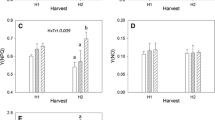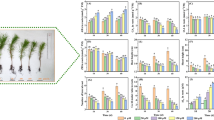Abstract
Effects of zinc (50–150 μM ZnSO4) on seed germinability, morphometric and physiological characteristics of Scots pine (Pinus sylvestris L.) seedlings during first 6 weeks of their development were studied. Scots pine turned out to be rather sensitive to elevated zinc concentrations. This was manifested in reduced seed germinability, root system growth retardation and suppression of its development (primarily, reduction in the size of the zone of secondary root formation, their number, and total length), a disturbance in the dynamics of biomass accumulation by various organs, primarily true needles, and also the content of main photosynthetic pigments. A specificity of zinc accumulation in seedling organs was established; it depended on the degree of root system development. A competition between cotyledons and needles for essential elements was observed. It was concluded that Scots pine high sensitivity to relatively low zinc concentrations (50–150 μM) makes it a more convenient model than currently used model plants (Arabidopsis thaliana L., Mesembryanthemum crystallinum L., Brassica napus L., and others) for studying physiological and molecular mechanisms of conifers adaptation to heavy metals and also for predictions of possible ecological consequences of environment pollution with zinc for tree phytocenoses.
Similar content being viewed by others
References
Kabata-Pendias, A. and Mukherjee, A.B., Trace Elements from Soil to Human, Berlin: Springer-Verlag, 2007.
Mineral Commodity Summaries, U.S. Geological Survey, 2011.
Callender, E., Heavy Metals in the Environment—Historical Trends, Treatise on Geochemistry, vol. 9, Holland, H.D. and Turekian, K.K., Eds, Amsterdam: Elsevier, 2003, pp. 67–105.
Nikonov, V.V., Lukina, N.V., Bezel’, V.S., Bel’skii, E.A., Bespalova, A.Yu., Golovchenko, A.V., Gorbacheva, T.T., Dobrovol’skaya, T.G., Dobrovol’skii, V.V., Zukert, N.V., Isaeva, L.G., Lapenis, A.G., Maksimova, I.A., Marfenina, O.E., Panikova, A.N., Pinskii, D.L., Polyanskaya, L.M., Stainnes, E., Utkin, A.I., Frontas’eva, M.V., Tsibul’skii, V.V., Chernov, I.Yu., and Yatsenko-Khmelevskaya, M.A., Rasseyannye elementy v boreal’nykh lesakh (Dissipated Elements in Boreal Forests), Isaev, A.S., Ed, Moscow: Nauka, 2004.
Hell, R. and Mendel, R.-R., Cell Biology of Metals and Nutrients, Berlin: Springer-Verlag, 2010.
Jain, R., Srivastava, S., Solomon, S., Shrivastava, A.K., and Chandra, A., Impact of Excess Zinc on Growth Parameters, Cell Division, Nutrient Accumulation, Photosynthetic Pigments and Oxidative Stress of Sugarcane (Saccharum spp.), Acta Physiol. Plant., 2010, vol. 32, pp. 979–986.
Lichtfouse, E., Navarrete, M., Debaeke, P., Souchere, V., and Alberola, C., Sustainable Agriculture, Berlin: Springer-Verlag, 2009.
Paschke, M.W., Perry, L.G., and Redente, E.F., Zinc Toxicity Thresholds for Reclamation for Species, Water Air Soil Pollut., 2006, vol. 170, pp. 317–330.
Reichman, S.M., Asher, C.J., Mulligan, D.R., and Menzies, N.W., Seedling Responses of Three Australian Tree Species to Toxic Concentrations of Zinc in Solution Culture, Plant Soil, 2001, vol. 235, pp. 151–158.
Kholodova, V.P., Volkov, K.S., and Kuznetsov, Vl.V., Adaptation of the Common Ice Plant to High Copper and Zinc Concentrations and Their Potential Using for Phytoremediation, Russ. J. Plant Physiol., 2005, vol. 52, pp. 748–757.
Ivanova, E.M., Kholodova, V.P., and Kuznetsov, Vl.V., Biological Effects of High Copper and Zinc Concentrations and Their Interaction in Rapeseed Plants, Russ. J. Plant Physiol., 2010, vol. 57, pp. 806–814.
Dunn, C.E., Biogeochemistry in Mineral Exploration, Handbook of Exploration and Environmental Geochemistry Series, vol. 9, Hale, M., Ed., Berlin: Springer-Verlag, 2007.
Yang, Y., Sun, C., Yao, Y., Zhang, Y., and Achal, V., Growth and Physiological Responses of Grape (Vitis vinifera “Combier”) to Excess Zinc, Acta Physiol. Plant., DOI: 10.1007/s11738-010-0687-3.
Hermle, S., Vollenweider, P., Gunthardt-Goerg, M.S., Mcquattie, C., and Matyssek, R., Leaf Responsiveness of Populus tremula and Salix viminalis to Soil Contaminated with Heavy Metals and Acidic Rainwater, Tree Physiol., 2007, vol. 27, pp. 1517–1531.
Durand, T.C., Hausman, J.F., Carpin, S., Alberic, P., Baillif, P., Label, P., and Morabito, D., Zinc and Cadmium Effects on Growth and Ion Distribution in Populus tremula × Populus alba, Biol. Plant., 2010, vol. 54, pp. 191–194.
Hartley-Whitaker, J., Cairney, J.W.G., and Meharg, A.A., Sensitivity to Cd or Zn of Host and Symbiont of Ectomycorrhizal Pinus sylvestris L. (Scots Pine) Seedlings, Plant Soil, 2000, vol. 218, pp. 31–42.
Krupa, P. and Kozdroj, J., Ectomycorrhizal Fungi and Associated Bacteria Provide Protection against Heavy Metals in Inoculated Pine (Pinus sylvestris L.) Seedlings, Water, Air, Soil Pollut., 2007, vol. 182, pp. 83–90.
Pravdin, L.F., Sosna obyknovennaya. Izmenchivost’, vnutrividovaya sistematika i selektsiya (Pinus sylvestris. Variability, Intraspecies Taxonomy, and Breeding), Moscow: Nauka, 1964.
Semena derev’ev i kustarnikov. Metody opredeleniya vskhozhesti (Seeds of Trees and Shrubs. Methods for Germinability Investigation), GOST 13056.6-97, 1998.
Lichtenthaler, H.K., Chlorophylls and Carotenoids, Pigments of Photosynthetic Biomembranes, Methods Enzymol., 1987, vol. 148, pp. 350–382.
Kaznina, N.M., Titov, A.F., Laidinen, G.F., and Talanov, A.V., Setaria viridis Tolerance of High Zinc Concentrations, Biol. Bull., 2009, vol. 36, pp. 575–581.
Shah, F.U.R., Ahmad, N., Masood, K.R., Peralta-Videa, J.R., and Ahmad, F.U.D., Heavy Metal Toxicity in Plants, Plant Adaptation and Phytoremediation, Ashraf, M., Ozturk, M., and Ahmad, M.S.A., Eds, Berlin: Springer-Verlag, 2010.
Adriaensen, K., Vangronsveld, J., and Colpaert, J.V., Zinc-Tolerant Suillus bovinus Improves Growth of Zn-Exposed Pinus sylvestris Seedlings, Mycorrhiza, 2006, vol. 16, pp. 553–558.
Colpaert, J.V. and van Assche, J.A., Zinc Toxicity in Ectomycorrhizal Pinus sylvestris, Plant Soil, 1992, vol. 143, pp. 201–211.
Stewart, J.McD., Oosterhuis, D., Heitholt, J.J., and Mauney, J., Physiology of Cotton, Berlin: Springer-Verlag, 2010.
Author information
Authors and Affiliations
Corresponding author
Additional information
Original Russian Text © Yu.V. Ivanov, Yu.V. Savochkin, Vl.V. Kuznetsov, 2011, published in Fiziologiya Rastenii, 2011, Vol. 58, No. 5, pp. 728–736.
Rights and permissions
About this article
Cite this article
Ivanov, Y.V., Savochkin, Y.V. & Kuznetsov, V.V. Scots pine as a model plant for studying the mechanisms of conifers adaptation to heavy metal action: 1. Effects of continuous zinc presence on morphometric and physiological characteristics of developing pine seedlings. Russ J Plant Physiol 58, 871–878 (2011). https://doi.org/10.1134/S1021443711050104
Received:
Published:
Issue Date:
DOI: https://doi.org/10.1134/S1021443711050104




